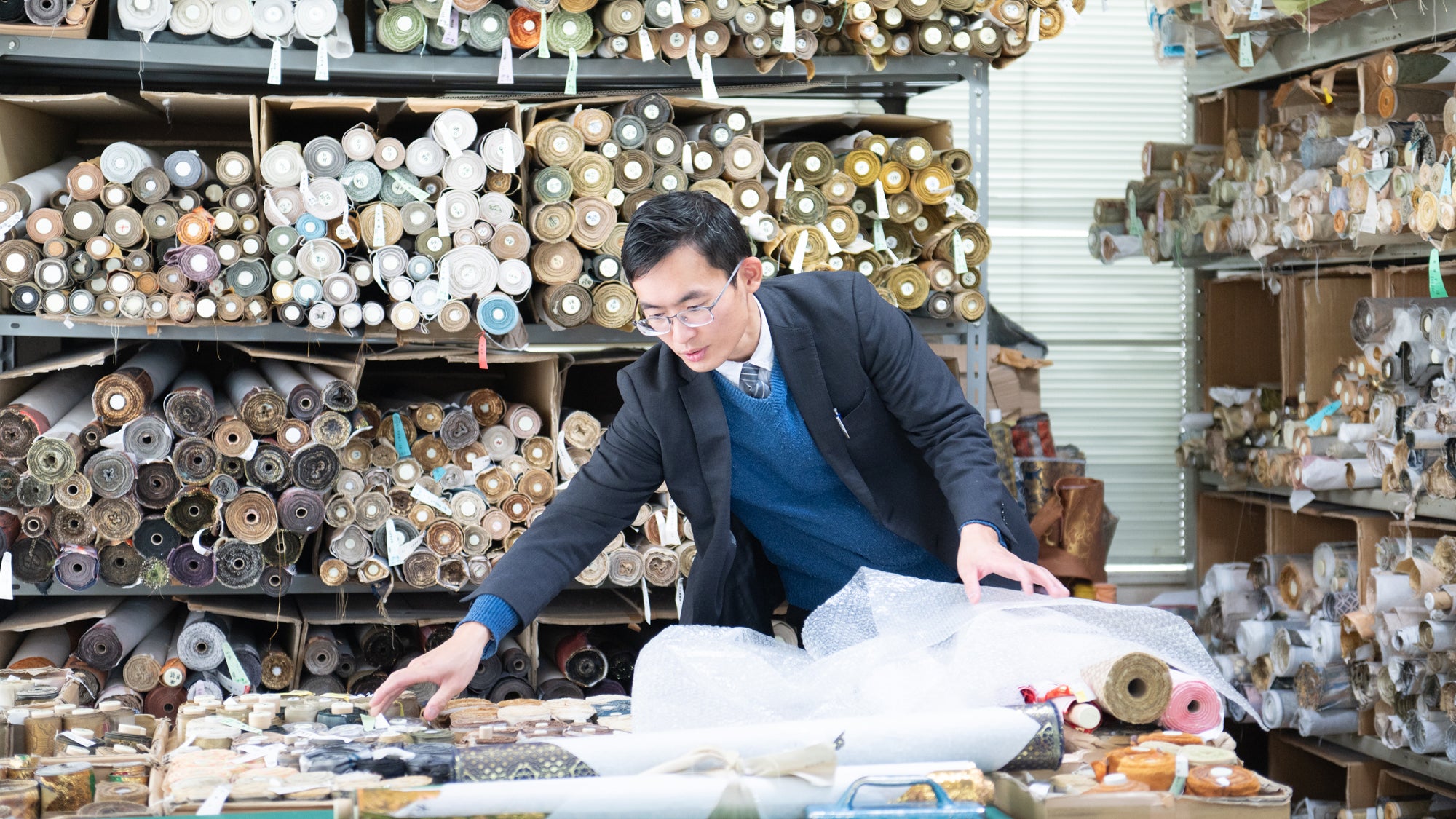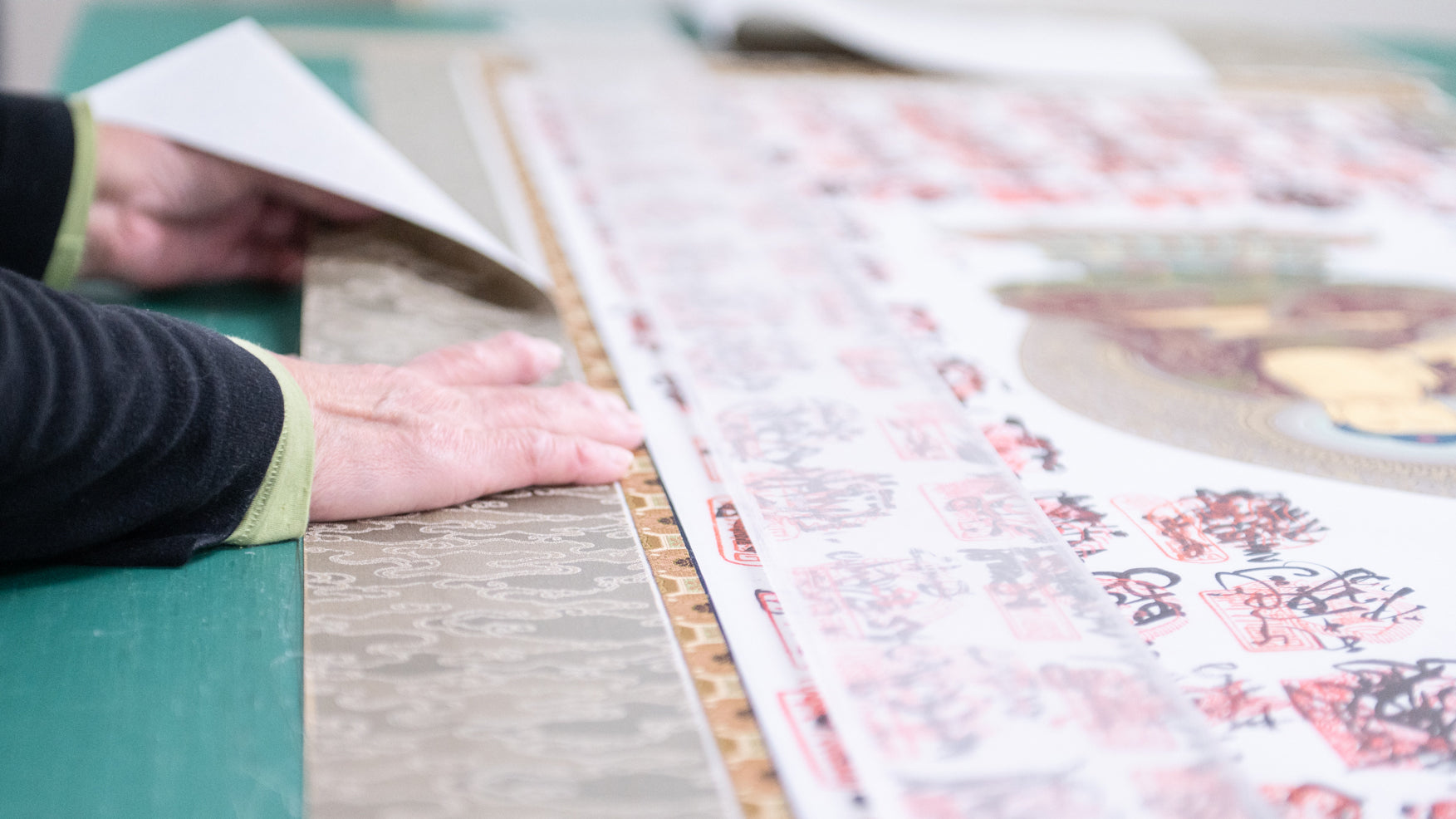This blog is the third installment of our visit to Kaitakudo Art by the MIYABI team. Kaitakudo Art is a company that consistently handles the mounting, painting, and sales of hanging scrolls. In the first and second blogs, we introduced the process of how hanging scrolls are mounted at the Kaitakudo Art workshop.

Visiting Kaitakudo Art Vol.3 - The Interview for RIN Chusei
In this third part, we will talk to RIN Chusei, who works in the sales department of Kaitakudo Art, to introduce the appeal of working in this industry and the future of hanging scrolls.
How Does RIN Enter This World
We had been in contact with RIN from Kaitakudo Art before this business trip, and I found that if you asked him one question about hanging scrolls, he would return with a hundred answers in detail.
He is originally from Hong Kong and shared the story of how he became interested in hanging scrolls in Gifu Prefecture.
"At the beginning, I was thinking about companies that support manufacturing businesses in Gifu Prefecture through Hello Work (unemployment office). It seems like the younger generation tends not to want to join companies that create these kinds of products. When I joined, I received a business manners lesson and training for six months with financial support from the government. The place where I was sent for this training was here, at Kaitakudo Art. However, the problem was the lack of routes for selling abroad. There were purchases of materials and sales of Chinese wood, but almost no sales of hanging scrolls overseas. It felt like a waste, and after the training ended, I decided to work here because I could use foreign languages."
RIN, working in the sales department at Kaitakudo Art, appeared lively and vibrant as he actively engaged in his work.
What Does RIN Find Rewarding in His Job
I asked RIN, who is dedicated to popularizing hanging scrolls, where he finds his job rewarding.
“A few years ago, a fellow trainee said, ‘There's a hanging scroll at my grandmother's house, but I don't understand it at all, could you teach me?’
It's very fulfilling to know about a part of culture that only a fraction of Japanese people are aware of.
Every time my fellow trainees tell me, ‘You know things about Japan that even Japanese people don't know,’ I feel proud of myself.”
He shared with a shy smile.
“Another thing is promoting this culture of hanging scrolls abroad. Since we handle many projects related to anime and characters, it's fun and rewarding to introduce things I love to people who are unfamiliar with them. Being able to freely come up with ideas and turn them into reality is what makes this job interesting.”
RIN said Kaitakudo Art is a traditional industry that continues to take on new challenges, which adds to its appeal.
Problems in the Hanging Scroll Industry (Issue of Succession)
Kaitakudo Art stands as a unique company within the specialized field of hanging scrolls. The harsh reality is that the industry cannot sustain itself without successors.
The factory manager of Kaitakudo Art comments:
“The job of creating hanging scrolls is specialized. It’s impossible to learn everything in just 10 years. It's already too late if it's not learned over 10, 20 years, but as of now, it's quite difficult. I think this is a common issue everywhere; framing shops like ours lack successors, and we're no longer receiving materials. We can't get fabrics even if we order them because there's no thread. Plus, parts for those machines as well. I believe the situation might get even worse in the future.”
The machines in the workshop are rare and can't be found easily nationwide. Once a machine breaks down, it's naturally difficult to find spare parts.
Hanging scrolls are traditionally displayed in alcoves, but as housing construction changes, they are disappearing. I asked RIN about their promotional activities.
“We distribute pamphlets we've created for general companies by inviting experts in hanging scrolls and mounting. We present to those who don’t know how to handle or are unfamiliar with hanging scrolls.”
The pamphlets on hanging scrolls we received not only explained how to handle them but also detailed the types of scrolls, the meanings of their themes, and the differences between luxury and budget scrolls. The differences are manifested through the artist's background, popularity, the fabric used in mounting, the painting materials used on the honshi “main work”, and the accessories included.
“There are things beyond human craftsmanship that money can't buy,” RIN says. This statement was impactful and has stayed with me. The items created by human hands carry the craftsman's intentions, embodying a brand story that cannot be quantified by price.
The Future of Kaitakudo Art
RIN is constantly on the move as part of the sales department, working to popularize hanging scrolls.
For those unfamiliar with handling hanging scrolls, he has prepared pamphlets detailing how to handle them. I received one of, which clearly explains the names of the parts of a hanging scroll and the meanings of the themes depicted. RIN mentioned that they also plan events involving general companies and specialists in hanging scrolls and mounting, utilizing these pamphlets.
Moreover, Kaitakudo Art participates in a group called kakejiku art.
This group is a Japanese hanging scroll brand that gathers top hanging scroll craftsmen and globally active artists, designers, and architects to spread hanging scroll works worldwide. The concept aims to propose the creation of joyful spaces by art collectors. Visiting the kakejiku art site, one can see a lineup of works where contemporary art and Japanese traditional beauty are fused.
Hanging scrolls often feature themes like nature and the four seasons. They are not only admired as prestigious art pieces but also serve to enrich our spiritual lives in a more personal way. Hanging scrolls are indeed a versatile canvas that reflect the times, adaptable even to scenes from anime, making them suitable for contemporary works.
The pamphlets on hanging scrolls we received not only explained how to handle them but also detailed the types of scrolls, the meanings of their themes, and the differences between luxury and budget scrolls. The differences are manifested through the artist's background, popularity, the fabric used in mounting, the painting materials used on the honshi “main work”, and the accessories included.
Related Blogs
Values and Culture
Our employee culture is as vibrant and diverse as the fashion industry itself. We foster a creative and collaborative environment where ideas are encouraged to flourish.
Sustainable Material
We believe in the power of sustainable fashion. That's why we carefully select eco-friendly materials to produce our clothing line. From organic cotton to recycled polyester, we are committed to reducing our environmental impact.
Giving Back
We believe in paying it forward. Our team engages in charitable efforts and volunteers their time to make a positive impact on our local community.





